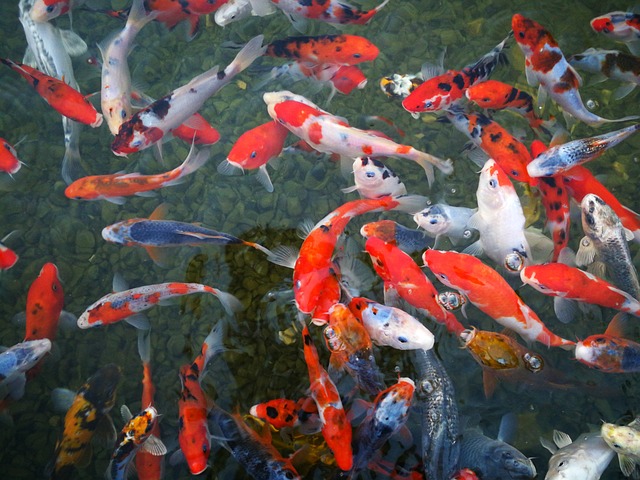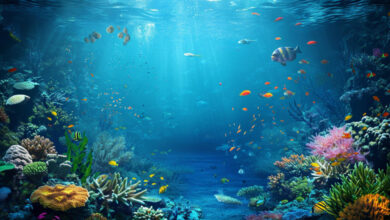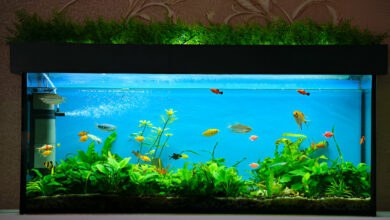Achieving Success with Koi Aquarium Filter Media for a Healthy Pond

Table of Contents
Adding a koi pond to your garden enhances its beauty with peaceful looks and the charming presence of bright koi fish. Nevertheless, it is essential to preserve a suitable habitat for these underwater animals. Understanding and utilizing the appropriate aquarium filter media is crucial for proper koi pond maintenance.
This blog post will delve into all aspects of koi aquarium filter media, including its significance, various types, selection process, and maintenance tips for ensuring the ideal filter media for your pond.
The significance of aquarium filter media.
Why the Filtration Matters
Filtration is essential for every Koi Aquarium or pond system. Filtration is crucial for koi ponds due to the large amount of waste produced by koi fish. If not filtered correctly, this waste can build up, resulting in low water quality and possibly endangering your fish. Efficient filtration with a proper pond filter system guarantees that your koi fish are provided with clean, oxygenated water to flourish in.
Different kinds of filtering
Three primary filtration methods are employed in koi ponds and Koi Aquarium.
Mechanical Filtration: This process eliminates debris and particles from the water through physical means.
Biological Filtration: This process utilizes helpful bacteria to convert ammonia and nitrites, which are harmful, into nitrates that are less harmful.
Chemical filtration involves using chemical processes like activated carbon or other media to eliminate impurities and toxins from the water.
The function of Filter Media
Filter media is the substance where filtration processes take place. It is responsible for capturing the waste, offering a platform for helpful bacteria to grow, and enabling chemical processes to purify the water. Selecting the correct filter media is essential in order to uphold a well-balanced and healthy environment for koi in your pond.
Different types of filter material
Media for filters made of mechanical components
Mechanical filter media works by physically eliminating particles from the water. Some typical examples are:
- Sponge filters are adaptable and suitable for different filter types. They are efficient in capturing dirt and simple to maintain.
- Filter pads and floss are usually arranged in layers to trap bigger debris initially, then capture smaller particles.
- Bead Filters: Commonly found in larger ponds, these filters utilize tiny beads to trap particles while water flows through them.
Media for filtering biological substances
Biological pond bio media offers a habitat for helpful bacteria that decompose harmful chemicals.
- Bio Balls: These plastic balls provide ample surface area for bacteria to inhabit. They are strong and simple to wash.
- Porous ceramic rings provide a large surface area and are very efficient for accommodating beneficial bacteria.
- Lava Rock: With its porous structure, this natural stone offers a great breeding ground for bacteria, even though it may degrade over time.
Media for filtering chemicals
Chemical filter media eliminates impurities by means of chemical reactions.
Activated Carbon is the most frequently used chemical media. It efficiently eliminates toxins, smells, and coloration from the water.
Zeolite is a valuable mineral in ponds with high fish populations as it has the ability to soak up ammonia.
Phosphate removers are utilized to manage algae growth by eliminating phosphates from the water.
Selecting the Proper Filter Media for Your Koi Pond
Evaluating the Requirements of Your Pond
Several factors determine the most suitable filter media for your pond.
- Size of the pond: Ponds that are bigger might need more advanced filtration systems that have various types of media.
- Fish Quantity: The size and quantity of your koi fish will impact the waste generation and, consequently, the required filtration.
- Water quality objectives: Specific concerns such as elevated ammonia levels or the proliferation of algae may require particular types of filtration media.
Blending Various Types of Media
Frequently, the most effective method involves utilizing a mixture of mechanical, biological, and chemical media. This versatile method guarantees thorough filtration, covering every aspect of water quality. Using various forms of media in your filter can increase how well it works and how effective it is.
Financial aspects to take into account.
Although certain filter media may come with a high cost, purchasing top-notch media can ultimately lead to cost savings by cutting down on maintenance requirements and avoiding expensive health problems for your koi fish. Take into account the advantages in the future while selecting filter materials.
Caring for Your Aquarium Filter Material
Routine maintenance
Frequent cleaning is necessary to ensure that your filter media is working at its best. Sponges and pads made from mechanical media should be washed frequently to eliminate any debris that has been caught. Handle with care to prevent harm to the media and any helpful bacteria that could be there.
Changing out media
All filter media in a Koi Aquarium, no matter how efficient, will require replacement at some point. Mechanical media may need to be replaced more often because of damage, while biological media can have a longer lifespan but might lose effectiveness. It is important to follow the manufacturer’s guidelines and replace chemical media such as activated carbon regularly in order to keep it effective.
Water Quality Surveillance
Test your pond water frequently to track levels of ammonia, nitrite, nitrate, and pH. This assists in assessing the efficiency of your filter media and implementing any needed changes. It is beneficial to maintain a record of water quality measurements to detect patterns and potential problems at an early stage.
Getting the most out of your filter media.
Improving the efficiency of Biological Filtration.
In order to enhance biological filtration, make sure there is sufficient oxygen circulation within the biological media. Good water circulation and aeration are essential in order for beneficial bacteria to thrive in your pond.
Avoiding blockages
Clogging can greatly diminish the efficiency of your filter material. Pre-filters can assist by trapping bigger debris before it reaches the primary filter material, decreasing the chance of blockages and extending the lifespan of your media.
Adjustments made for different times of the year.
The ecosystem of your pond or Koi Aquarium can be impacted by seasonal variations. In the colder months, koi’s metabolism decreases which leads to a decrease in waste production. Nonetheless, in the warmer seasons, the heightened activity and consumption may result in elevated waste amounts, necessitating more frequent upkeep of your filter media.
Errors to steer clear of in order to be successful
Exceeding the Capacity of the Filter
Overloading your pond with an excessive number of fish can strain your filter system, resulting in lower water quality and fish experiencing stress. Make sure that your fish load matches the capacity of your filtration system.
Ignoring upkeep
Failure to regularly maintain can result in media blockages, decreased filtration effectiveness, and declining water quality. Establish a regular maintenance plan for your pond and adhere to it to ensure that it remains in excellent condition.
Utilizing Media That Are Not Compatible
Some filter media do not function effectively in combination. Make sure the media you select work well together and enhance each other’s capabilities. If you are uncertain about the optimal pond combination, seek advice from a specialist.
The Consequences of Filter Media on the Environment
Environmentally-friendly Options
Think about environmentally friendly filter media choices such as organic fibers and reusable media. These options can help lessen your impact on the environment and support a more eco-friendly approach to maintaining a pond.
Appropriate way to get rid of something
When you need to change your filter media, make sure to get rid of it in the correct way. Certain media, such as activated carbon, may pose a threat to the environment if not properly disposed of. Adhere to the regulations in your area when disposing of or recycling items.
Promoting environmentally friendly initiatives.
Back brands and manufacturers who focus on sustainability in their products. Numerous businesses are currently manufacturing eco-conscious filter media that are efficient and environmentally friendly.
Improving Your Koi Pond Enjoyment
Appearance and style of something that is appealing to the eyes.
A properly cared for koi pond with clear water improves the aesthetic charm of your garden. Choosing the correct filter media will help to keep your pond beautiful, allowing your koi fish to shine at their best.
Fish that are in better health
Having healthy fish relies on having clean water. Utilizing the correct filter media can establish a healthy and lasting environment for your koi, ensuring their well-being and longevity. Fish that are in good health exhibit higher levels of activity, show more vibrant colors, and have a lower susceptibility to illnesses.
Finding pleasure in the journey
Taking care of a koi pond can bring satisfaction and pleasure as a hobby. Knowing how filter media works and using it correctly helps you to ensure the well-being and aesthetic appeal of your pond.
Summary
A properly maintained koi pond reflects the commitment and attention given by its owner. Understanding the significance of aquarium filter media, selecting appropriate varieties, and caring for them correctly will help you create a healthy habitat for your koi. Keep in mind, a healthy pond depends on finding equilibrium and maintaining regularity. Enjoy taking care of your pond!



